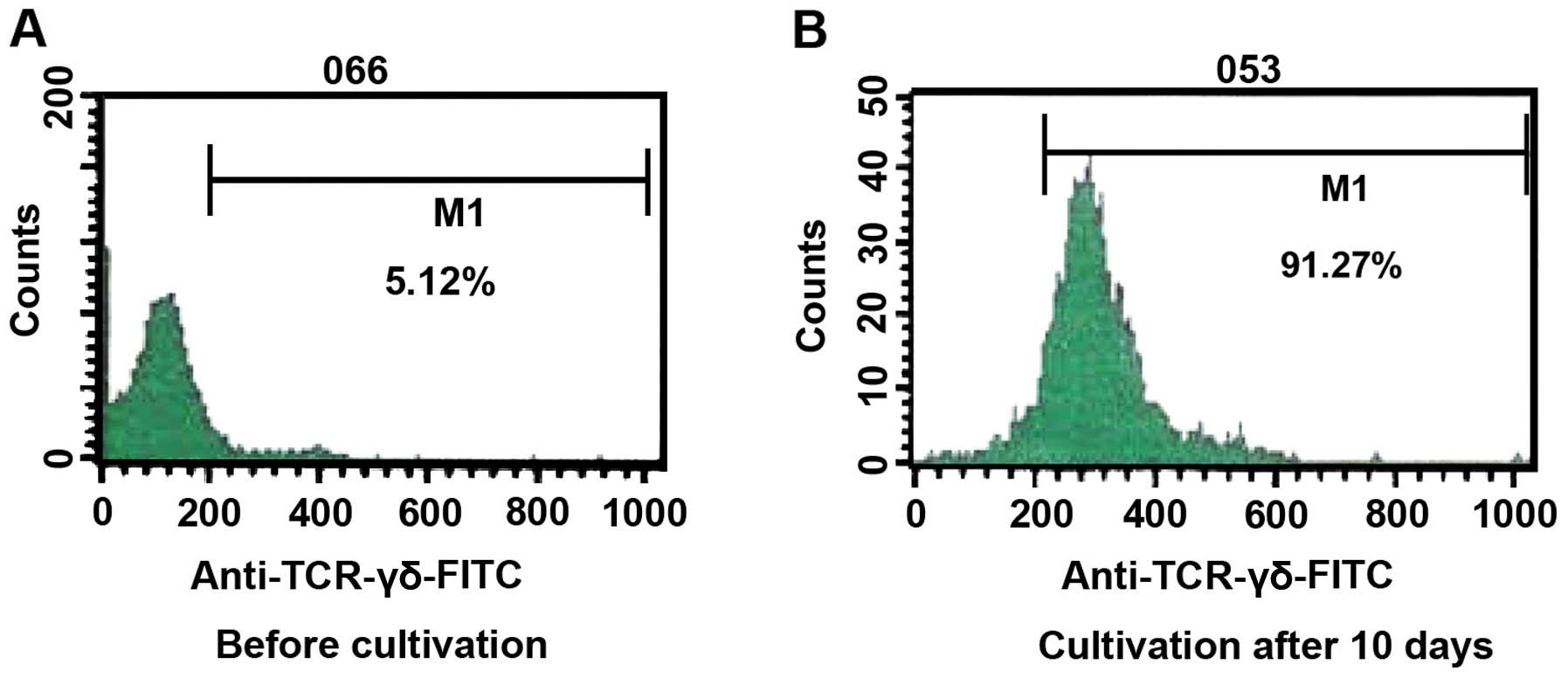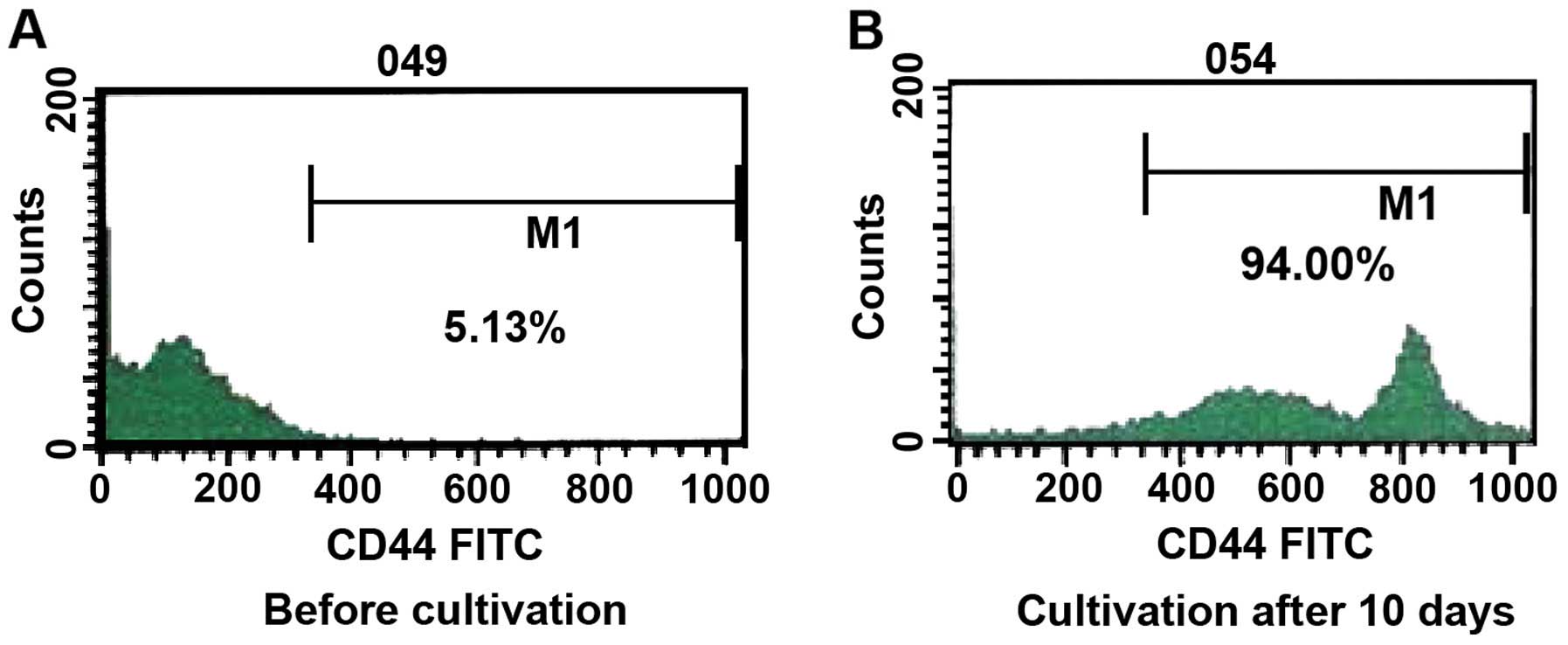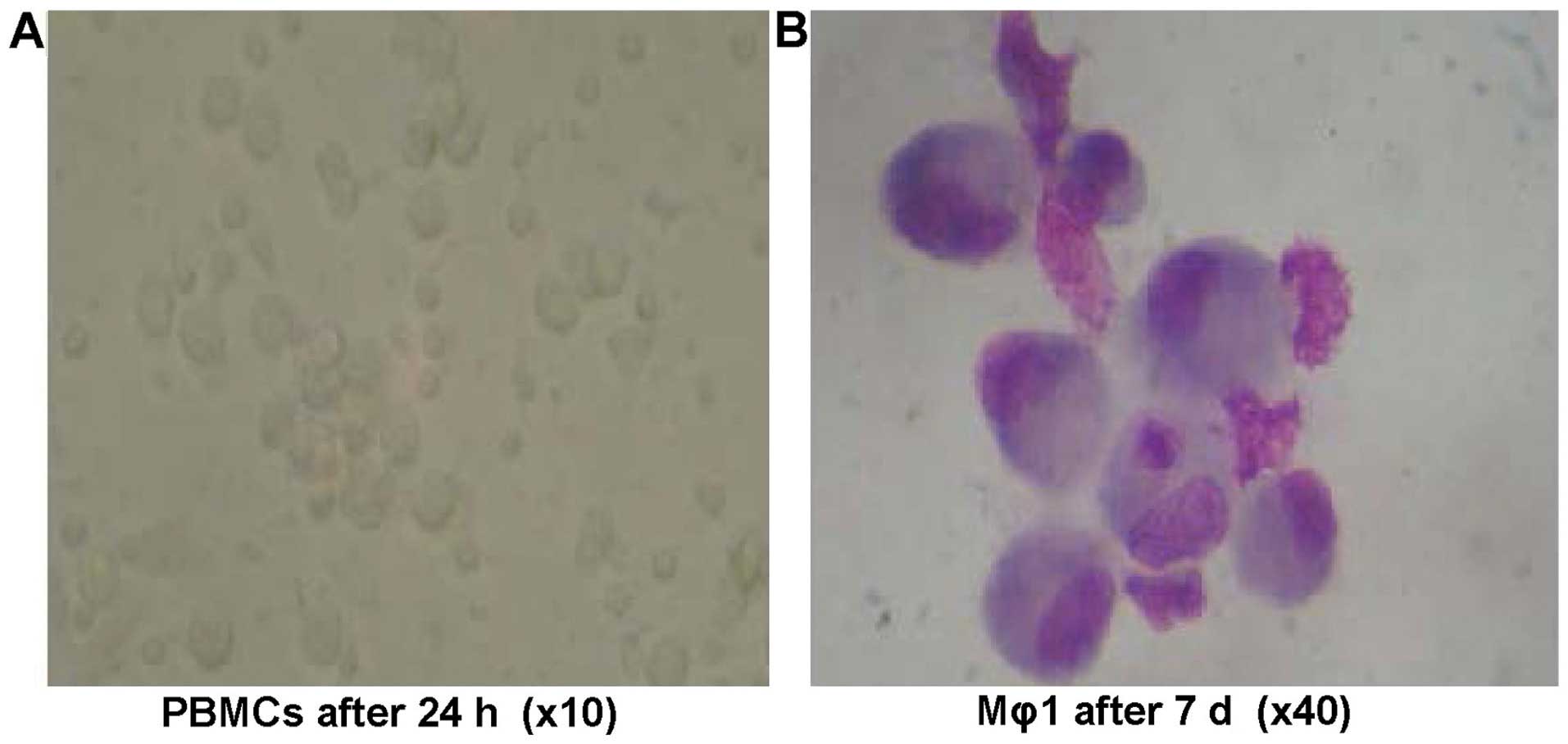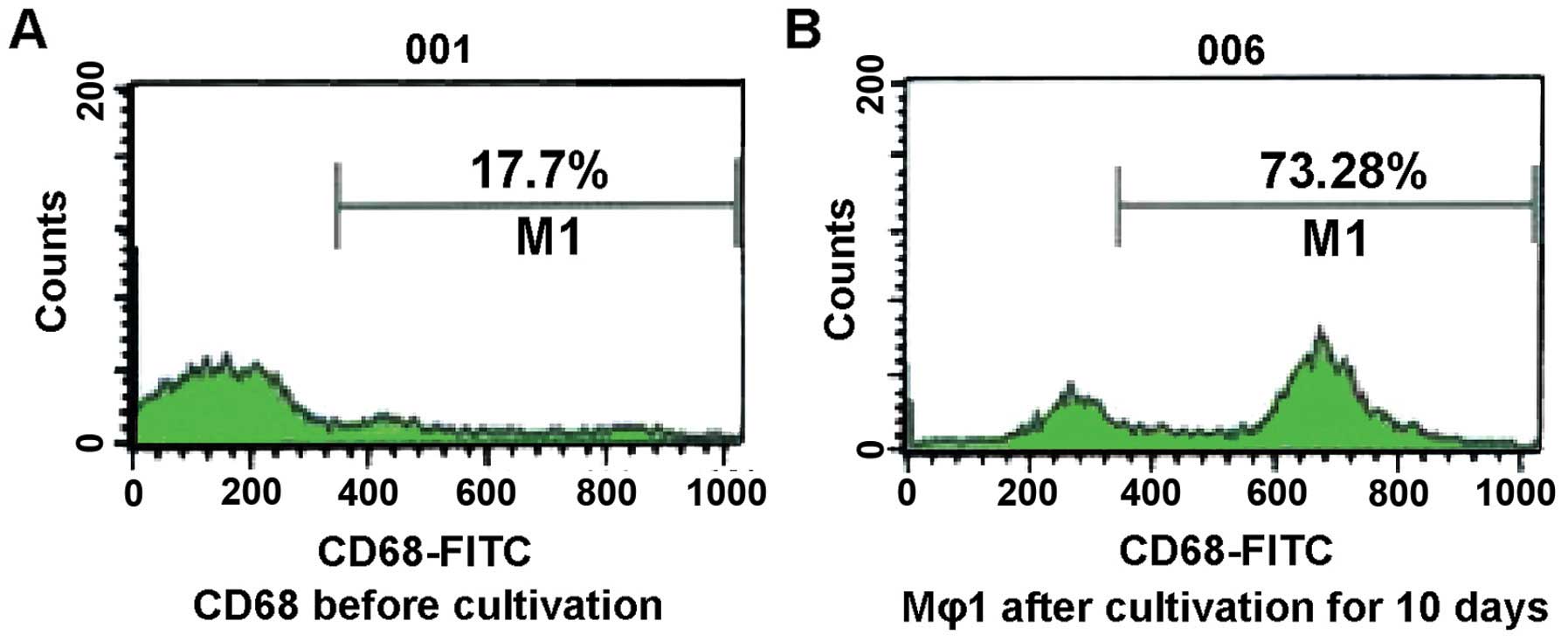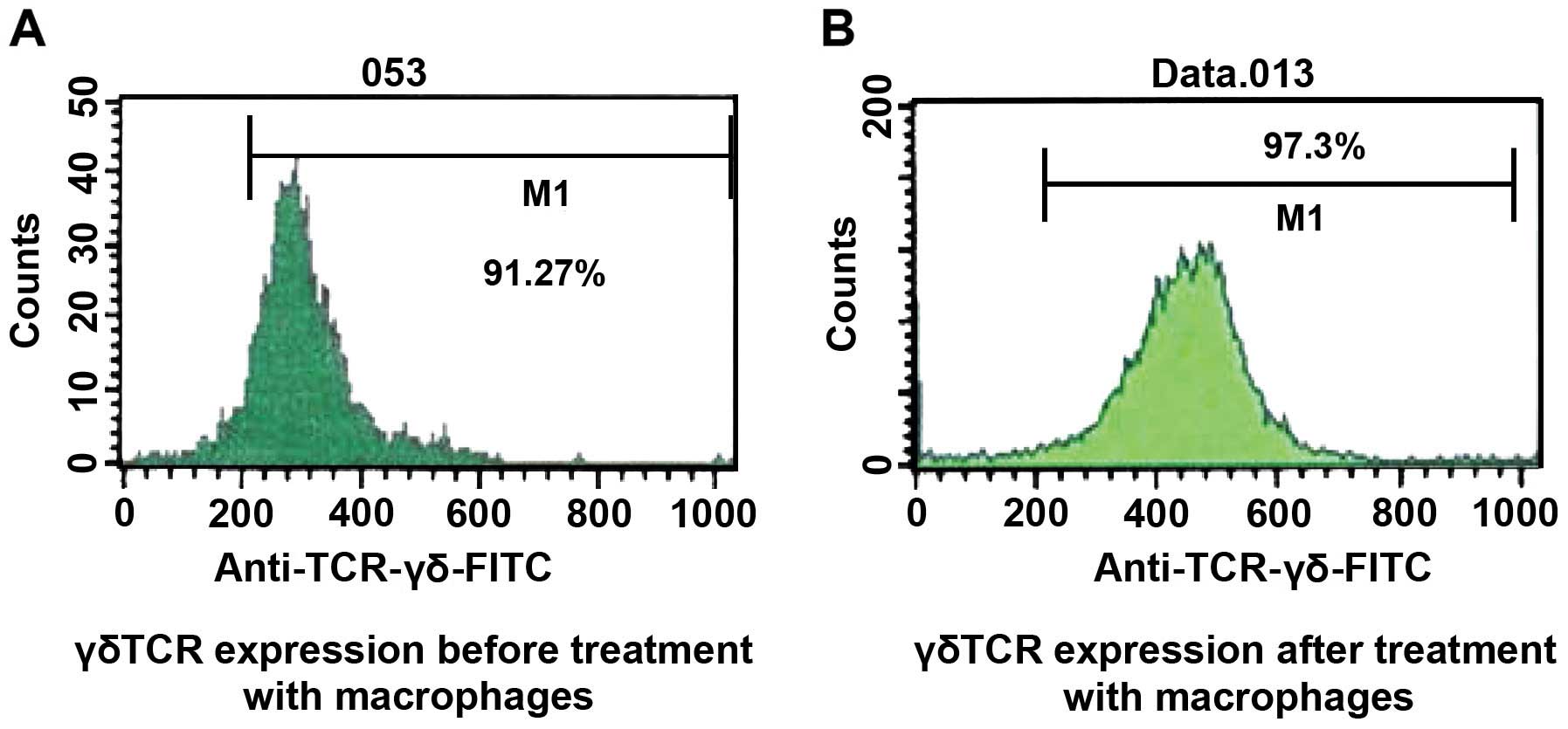The effect of activated Mφ1 on γδT cell-mediated killing of gastric cancer cells in vitro
- Authors:
- Published online on: August 30, 2016 https://doi.org/10.3892/ol.2016.5066
- Pages: 3368-3372
-
Copyright: © Xia et al. This is an open access article distributed under the terms of Creative Commons Attribution License.
Abstract
Introduction
Gastric carcinoma is a common human malignancy with a high incidence, including in countries such as China (1). The morbidity and mortality associated with gastric carcinoma is the leading cause of all malignancies worldwide (2). A recent epidemiological study revealed that the 5-year survival rate of gastric carcinoma was approximately 90% (3). Thus, it is important to study and improve its prevention and treatment alternatives.
Immunotherapy is a relatively new treatment method based on the manipulation of various immune cells for cancer treatment. This treatment can improve the ability of recognition and presentation of tumor antigens by the immune system, resulting in a reduction in the incidence of tumor recurrence and metastasis (4–6). However, to achieve this, immunotherapy should be able to direct the innate immunity and adaptive response that exerts an antitumor effect (7,8). Μononuclear cells can be differentiated into classically activated macrophages (CAMs/Mϕ1) by granulocyte macrophage colony-stimulating factor (GM-CSF) and play a key role in the induction of the specific immune response and immunological regulation (9,10). The γδT cells are an important subset of the T-cell population of the innate immune system in vivo, and have an important role in tumor immune surveillance (11). Currently, studies concerning the interactions of Mϕ1 and γδT cells are mostly limited to inflamed tissues (12,13). To the best of our knowledge, the influence of Mϕ1 on the antitumor effect of γδT cells has yet to be reported.
We hypothesized that Mϕ1 can signal γδT cells to achieve a comprehensive cellular immunotherapeutic effect that may improve the elimination of cancer cells. To test this hypothesis, we used the supernatant of in vitro cultured Mϕ1 to signal γδT cells and documented the effects on their proliferation, cell surface marker expression and cytotoxicity against gastric cancer cells. In addition, we examined the possible mechanisms involved in the findings and the opportunity for more direct tests for an immunotherapeutic approach.
Materials and methods
Materials
The human SGC-7901 gastric cancer cell line was obtained from the Shanghai Institute of Biochemistry and Cell Biology (Shanghai, China). rhGM-CSF was purchased from Promega Corp. (Madison, WI, USA), and rhIL-2 and rhIFN-γ were purchased from Xiamen Amoytop Biotech Co., Ltd. (Xiamen, China). RPMI-1640 medium, calf serum and tryptase were purchased from Gibco (Grand Island, NY, USA). Methyl thiazolyl tetrazolium (MTT) and dimethyl sulfoxide (DMSO) were purchased from Sigma (St. Louis, MO, USA). Isopentenyl pyrophosphate (IPP), PE-labeled mouse anti-human monoclonal antibody CD3, FICT-labeled mouse anti-human monoclonal antibodies CD68, CD44, and γδTCR were purchased from MultiSciences (Lianke) Biotech Co., Ltd. (Hangzhou, China). Interleukin (IL)-10, IL-12 were analyzed using the commercially available kit from Gibco. Lactate dehydrogenase (LDH) was assayed using the commercially available kit by Shino-Test Corp. (Tokyo, Japan).
Culture and identification of γδT cells
Approximately 10 ml of peripheral blood with heparin/EDTA as anticoagulant were drawn aseptically from healthy donors and added to lymphocyte separation medium. Centrifugation was performed at 1,500 × g for 15 min and the peripheral blood mononuclear cells (PBMCs) were separated. The PBMCs were washed three times with normal saline (each wash consisted of centrifugation at 1,000 × g/for 10 min) and then added to RPMI-1640 medium supplemented with 10% calf serum, 5% human AB serum, IL-2 150 kU/l and IPP 2 µg/l. The γδT cells were cultured according to the method described by Chen et al and Liu et al (14,15). The γδT cells that had been cultured for 10 days were then collected to detect the cell surface markers γδTcR and CD44, and to determine the growth and cytotoxicity of γδT cells.
Macrophage culture
Six healthy volunteers were chosen and 200 ml blood were drawn from each volunteer. PBMCs were separated with lymphocyte separation medium. RPMI-1640 complete medium was used to dilute PBMCs to 2×109/l, and the diluted PBMCs were seeded in 6-well plates with 5 ml for each well. The cells were then cultured at 37°C for 2 h with 5% CO2. The unattached cells were washed with phosphate-buffered saline (PBS) and the cells that adhered were washed with warm saline only once. The attached cells were then cultured with RPMI-1640 medium that contained 700 kU/l GM-CSF and 10% FBS at 37°C with 5% CO2. Half of the medium was changed once every 2 days, interferon (IFN)-γ of 166 kU/l was added on the sixth day, incubated for 24 h and Mϕ1 was retrieved.
Detection of the expression of macrophage surface marker CD68 using flow cytometry
Mϕ1 cultured for 7, 10 and 13 days were digested with trypsin and the cell concentrations were adjusted to 5×109/l with PBS. Centrifugation, washing and resuspension were performed with PBS. Approximately 100 µl of the cells were then resuspended in centrifuge tubes. CD68 was labeled with a fluorescent marker (FITC-labeled) to a final concentration of 5 mg/l and incubated in the dark at 4°C for 20 min. The unattached label was washed off with PBS and the cell phenotype was detected using a flow cytometer (Amnis Corp., Seattle, USA).
Detection of the effect of Mϕ1 culture supernatant on γδT cell proliferation using MTT
γδT cells cultured for 10 days were diluted to obtain a final concentration of 1×109/l. Subsequently, 0.2 ml of the cell suspension were added to each of the wells in a 96-well plate. Each group had 5 wells in replicates. The plates were incubated at 37°C in the presence of 5% CO2 for 24 h. This was followed by addition of the culture supernatants of Mϕ1, which were cultured for 10 days in each well. No Mϕ1 supernatant was added to the control group. The cells were then cultured for another 72 h under the same conditions and 20 µl of MTT was added into each well and incubated for 4 h. The supernatant was removed and 100 µl of DMSO was added per well, and mixed for 10 min. When the precipitate was completely dissolved, the absorbance (A) of each well was detected at 570 nm wavelength using ELISA. The cell proliferation rate was calculated using the formula: cell proliferation = value for test group/value for control group - 1) × 100%.
Detection of the effect of Mϕ1 culture supernatant on γδT cell phenotype using a flow cytometer
γδT cells, cultured for 10 days with Mϕ1 supernatant (test group) or without Mϕ1 supernatant (control group) were collected. In the test group, the volume ratio of Mϕ1 culture supernatant to RPMI-1640 medium was 1:8. The concentration of cells was adjusted to 2×109/l with PBS and 100 µl of cell suspension was taken in centrifuge tubes. FITC-labeled γδTCR and anti-human CD44-FITC antibodies were added to the centrifuge tubes at a final concentration of 5 mg/l, incubated in the dark at 4°C for 20 min, washed with PBS and detected using a flow cytometer.
Measurement of tumor cytotoxic effect of γδT cells following treatment with Mϕ1 culture supernatant
Cell cytotoxicity was detected using the LDH-release method. SGC-7901 gastric cancer cells were cultured to the logarithmic phase using high-glucose Dulbecco's modified Eagle's medium (DMEM). The cells were collected and washed with Hank's balanced salt solution twice and then prepared at a concentration of 2×108/l. The γδT cells that were induced for 72 h at different concentrations (either 1:4, 1:8, 1:32 or 1:64) of Mϕ1 supernatant to RPMI-1640 were used as effector cells at a concentration of 2×109/l. The SGC-7901 gastric cancer and effector γδT cells were mixed at a ratio of 10:1. After centrifugation at 500 rpm for 5 min, the cells were incubated at 37°C for 6 h in the presence of 5% CO2. The cells were mixed gently and centrifuged at 1,500 rpm for 10 min. Each group of cells had replicates. The control group consisted of γδT cells that had no Mϕ1 supernatant added to them. After the incubation period, the culture supernatants of each group of cells were collected and used to detect the activity of LDH (U/l). The cytotoxicity of γδT cells was calculated using the formula: cytotoxicity of γδT cells = (LDH units of test tubes - LDH units released from effector cells)/(LDH units of maximum release tubes - LDH units released from target cells) × 100%.
Statistical analysis
SPSS 19.0 (Chicago, IL, USA)was used to analyze the results. The values were presented as mean ± standard deviation (SD). The t-test was used to compare the two groups, while one-way analysis of variance was used for comparison between groups. P<0.05 was considered statistically significant.
Results
Cultures, γδT cell phenotype and assessment of cell purity
PBMCs had adherent growth after culturing for 24 h, in the γδT cell induction system. The cell colony size markedly increased after 48 h of cultivation. A single adherent cell layer was apparent after 10 days of cultivation. The individual cells presented a fusiform shape and few suspended cells were found. The cells collected before and after cultivation were labeled with mAb fluorescence, and then detected and analyzed by flow cytometry. Prior to cultivation, the ratio of γδT cells was 5.12% of the total, and the expression of CD44 was 5.13%. After cultivation for 10 days, the percentage of γδT cells was 91.27% and the percentage of expression of CD44 was 94.00% a reliable indicator of the purity of the γδT cells (Figs. 1 and 2).
Cultures, Mϕ1 phenotype and assessment of cell purity
In the Mϕ1 induction system, PBMCs were shown to have adherent growth after culturing for 24 h. Cell colonies of 3–6 cells became apparent after 48 h of cultivation. A bigger colony and few single adherent cells were observed after 7 days of culture and each individual cell appeared irregular in shape. Morphological characteristics of macrophages were apparent after 7 days. The cells appeared large in volume and oval or irregular in shape. The nuclei of the cells were oval or irregular in shape. Loose chromatin was present inside irregular nuclear membranes with protrusions. The cytoplasms and pseudopodia were abundant and stained with gray blue. The percentage of expression on the cell surfaces of CD68 among the cells was 17.7% before cultivation, and 73.2% after cultivation (Figs. 3 and 4).
Effect of Mϕ1 culture supernatant on the proliferation of γδT cells
The proliferation of γδT cells in the test groups that received different concentrations of Mϕ1 supernatant was significantly higher than that in the control group which did not receive any supernatant (P<0.01). Within the supernatant:medium 1:1 to 1:8 ratio groups, the proliferation of γδT cells increased with decreasing concentrations of Mϕ1 supernatant, reaching a peak (33.8% of cells) at the 1:8 ratio. The proliferation decreased by small degrees when the volume ratios used were <1:16 (Table I).
Effect of Mϕ1 culture supernatant on the expression of the γδT cell surface marker γδTCR
The percentage of expression of the γδT cell surface marker γδTCR was 97.3% after treatment with Mϕ1 culture supernatant, while that of the control group was only 91.27%. This difference was found to be statistically significant (P<0.05) (Fig. 5).
Effect of Mϕ1 culture supernatant on the tumor cytotoxic effect of γδT cells
The tumor cytotoxic effect of γδT cells in the test groups treated with different concentrations of Mϕ1 supernatant was always higher than the effect in the control groups (P<0.01). Within the groups treated with 1:4 to 1:16 supernatant:medium ratios the tumor-cytotoxic effect of γδT cells was higher in the group treated with a 1:16 solution, reaching a peak (70.18%) at the volume ratio of 1:16, while the proliferation ratio was decreased slightly when the volume ratio used was <1:16 (Table II).
Discussion
Macrophages have many functions including phagocytosis, antigen presentation, and secretion of cytokines. They occupy a central position within the cellular and molecular networks composed of immune and non-immune cells and various cytokines. Macrophages are also key players in the induction and regulation of specific immune responses (16).
Baron-Bodo et al cultured Mϕ1 treating them with GM-CSF and IFN-γ and proved that IFN-γ activates Mϕ1 and enhances their antitumor effects (17). GM-CSF induces macrophage proliferation and enhances their cancer cytotoxicity on cells in vitro. In addition, GM-CSF induces the macrophages to secrete inflammatory cytokines (18,19). CD68 is a transmembrane glycoprotein with a molecular weight of 110 kDa that is distributed on the cell surface of macrophages. Although there are only scarce CD68 glycoproteins on the surface of monocytes, their expression is increased significantly as monocytes differentiate into macrophages, allowing the marker to be used for the detection of human macrophages (20). In the present study, it was found that the expression of CD68 on the surface of the cells had increased after cultivation. The percentage of the cells carrying the CD68 marker increased from 17.7% to 73.2%. This finding suggests that our experiment successfully transformed human PBMCs into macrophages.
γδT cells are an important subset of the innate immunity population of T cells in vivo, and account for 5–15% of T cells in peripheral blood. γδT recognize various antigens in an MHC unrestricted manner and are widely distributed in the epithelial tissues of the digestive and respiratory tracts. Nevertheless, there are some γδT cells circulating in peripheral blood (21). Previous studies have shown that γδT cells play an important role in tumor immune surveillance and immunotherapy (22–26).
γδTCR, expressed on the surface of γδT cells, is a receptor mainly associated with inflammation, tumor and other immune responses. Dalton et al showed that the interaction of macrophages and γδT cells is characteristic of the Vδ1 subtype with induction of the TCR (27,28). γδTCRs affect the antigen-presenting function, cytokine secretion profile, inflammatory reaction and tumor immunity action of macrophages. In addition, the cytotoxicity of γδT cells correlates with the presence of ligands on tumor cells, such as MICA/MICB and ULBPI-4. In the present study, treating γδT cells with Mϕ1 culture supernatant resulted in an increased expression of the cell surface marker γδTCR, suggesting that Mϕ1 can upregulate the expression of γδTCR.
The MTT experiment showed that when γδT cell cultures were treated with a Mϕ1 culture supernatant mixture, the proliferation of the γδT cells was higher than the proliferation of the control cells grown without Mϕ1 culture supernatant. The proliferation of γδT cells reached a peak, becoming 33.8% of the cells in the repertoire, at the supernatant:media volume ratio of 1:8. It was concluded that, the Mϕ1 supernatant promotes the growth of γδT cells and provides a new approach for the improvement of immunotherapy methods. Furthermore, the present findings showed that Mϕ1 culture supernatant adds strength to the cell-killing effect of γδT cells on human SGC-7901 gastric adenocarcinoma cells in vitro. We suggest that the effect may be due to the hyper-secretion by the Mϕ1 of Th1-promoting cytokines, such as IL-12, which promote T-cell proliferation. IL-12 was first described as a maturation factor of cytotoxic T lymphocytes and an activator of the natural killer (NK) cells alone. However, the variety of functions of IL-12 increased to include, inducing peripheral blood lymphocytes to produce IFN-γ, enhancing the cytotoxicity of NK cells, promoting the T-cell proliferation and releasing the cytokines IFN-γ and TNF-α. Thus, IL-12 plays a role in the immune killing of tumor cells. It is possible that IL-12, which is present in the Mϕ1 supernatant, activates the γδTCR of γδT cells, which in turn upregulates the expression of FasL, which induces the apoptosis of gastric cancer cells. The present study excluded the direct cell-cell contact effects by using only the supernatant of activated macrophages and γδT cells.
The findings of the present study have shown that activated macrophages can induce human γδT cells to kill SGC-7901 gastric cancer cells. Thus, the immunotherapeutic treatment of gastric carcinoma combining activated macrophage supernatant and γδT cells is a potentially successful anticancer strategy. Such treatment may kill tumor cells immediately, bypassing the restrictions imposed by MHC-restricted killing of cancer cells. Additionally, it may improve the functions of the antitumor immune network by ensuring the interaction between various immune cells and enhancing the effect of cytokines. Nevertheless, the exact mechanisms of action and the cell pathways involved remain to be investigated prior to considering the implementation of such a method in anticancer therapy.
References
|
Sun XD, Mu R, Zhou YS, Dai XD, Zhang SW, Huangfu XM, Sun J, Li LD, Lu FZ and Qiao YL: Analysis of mortality rate of stomach cancer and its trend in twenty years in China. Zhonghua Zhong Liu Za Zhi. 26:4–9. 2004.(In Chinese). PubMed/NCBI | |
|
Patru CL, Surlin V, Georgescu I and Patru E: Current issues in gastric cancer epidemiology. Rev Med Chir Soc Med Nat Iasi. 117:199–204. 2013.PubMed/NCBI | |
|
Khan MI, Baqai MT, Bukhari M and Hashmi RI: Gastric carcinoma: 5 years survival after gastric surgery. J Pak Med Assoc. 55:158–160. 2005.PubMed/NCBI | |
|
Dunn GP, Old LJ and Schreiber RD: The three Es of cancer immunoediting. Annu Rev Immunol. 22:329–360. 2004. View Article : Google Scholar : PubMed/NCBI | |
|
Verreck FA, de Boer T, Langenberg DM, Hoeve MA, Kramer M, Vaisberg E, Kastelein R, Kolk A, de Waal-Malefyt R and Ottenhoff TH: Human IL-23-producing type 1 macrophages promote but IL-10-producing type 2 macrophages subvert immunity to (myco)bacteria. Proc Natl Acad Sci USA. 101:4560–4565. 2004. View Article : Google Scholar : PubMed/NCBI | |
|
Kabelitz D, Wesch D and He W: Perspectives of gammadelta T cells in tumor immunology. Cancer Res. 67:5–8. 2007. View Article : Google Scholar : PubMed/NCBI | |
|
Casetti R and Martino A: The plasticity of gamma delta T cells: innate immunity, antigen presentation and new immunotherapy. Cell Mol Immunol. 5:161–170. 2008. View Article : Google Scholar : PubMed/NCBI | |
|
Born WK, Reardon CL and O'Brien RL: The function of gammadelta T cells in innate immunity. Curr Opin Immunol. 18:31–38. 2006. View Article : Google Scholar : PubMed/NCBI | |
|
Harris KM: Monocytes differentiated with GM-CSF and IL-15 initiate Th17 and Th1 responses that are contact-dependent and mediated by IL-15. J Leukoc Biol. 90:727–734. 2011. View Article : Google Scholar : PubMed/NCBI | |
|
Barilli A, Rotoli BM, Visigalli R, Bussolati O, Gazzola GC, Kadija Z, Rodi G, Mariani F, Ruzza ML, Luisetti M and Dall'Asta V: In lysinuric protein intolerance system y+l activity is defective in monocytes and in GM-CSF-differentiated macrophages. Orphanet J Rare Dis. 5:322010. View Article : Google Scholar : PubMed/NCBI | |
|
Moser B and Brandes M: Gammadelta T cells: an alternative type of professional APC. Trends Immunol. 27:112–118. 2006. View Article : Google Scholar : PubMed/NCBI | |
|
Kobayashi H, Tanaka Y, Yagi J, Osaka Y, Nakazawa H, Uchiyama T, Minato N and Toma H: Safety profile and anti-tumor effects of adoptive immunotherapy using gamma-delta T cells against advanced renal cell carcinoma: a pilot study. Cancer Immunol Immunother. 56:469–476. 2007. View Article : Google Scholar : PubMed/NCBI | |
|
Bennouna J, Bompas E, Neidhardt EM, Rolland F, Philip I, Galéa C, Salot S, Saiagh S, Audrain M, Rimbert M, et al: Phase-I study of Innacell gammadelta, an autologous cell-therapy product highly enriched in gamma9delta2 T lymphocytes, in combination with IL-2, in patients with metastatic renal cell carcinoma. Cancer Immunol Immunother. 57:1599–1609. 2008. View Article : Google Scholar : PubMed/NCBI | |
|
Chen FX, Liu JQ, Xia F, Zhang J and Zhang S: A new method for the amplification of human γδT cells. Chin Cell Mol Immunol. 23:662–664. 2007.(In Chinese). | |
|
Liu JQ: The detection of LAK cell activity by LDH kit. Chin J Clin Lab Sci. 13:831995.(In Chinese). | |
|
Smith PD, Ochsenbauer-Jambor C and Smythies LE: Intestinal macrophages: Unique effector cells of the innate immune system. Immunol Rev. 206:149–159. 2005. View Article : Google Scholar : PubMed/NCBI | |
|
Baron-Bodo V, Doceur P, Lefebvre ML, Labroquère K, Defaye C, Cambouris C, Prigent D, Salcedo M, Boyer A and Nardin A: Anti-tumor properties of human-activated macrophages produced in large scale for clinical application. Immunobiology. 210:267–277. 2005. View Article : Google Scholar : PubMed/NCBI | |
|
Wallace PK, Romet-Lemonne JL, Chokri M, Kasper LH, Fanger MW and Fadul CE: Production of macrophage-activated killer cells for targeting of glioblastoma cells with bispecific antibody to FcgammaRI and the epidermal growth factor receptor. Cancer Immunol Immunother. 49:493–503. 2000. View Article : Google Scholar : PubMed/NCBI | |
|
Solinas G, Germano G, Mantovani A and Allavena P: Tumor-associated macrophages (TAM) as major players of the cancer-related inflammation. J Leukoc Biol. 86:1065–1073. 2009. View Article : Google Scholar : PubMed/NCBI | |
|
Gordon S: Alternative activation of macrophages. Nat Rev Immunol. 3:23–35. 2003. View Article : Google Scholar : PubMed/NCBI | |
|
Kondo M, Izumi T, Fujieda N, Kondo A, Morishita T, Matsushita H and Kakimi K: Expansion of human peripheral blood gammadelta T cells using zoledronate. J Vis Exp. Sep 9–2011.(Epub ahead of print). View Article : Google Scholar : PubMed/NCBI | |
|
Beck BH, Kim HG, Kim H, Samuel S, Liu Z, Shrestha R, Haines H, Zinn K and Lopez RD: Adoptively transferred ex vivo expanded gammadelta-T cells mediate in vivo antitumor activity in preclinical mouse models of breast cancer. Breast Cancer Res Treat. 122:135–144. 2010. View Article : Google Scholar : PubMed/NCBI | |
|
Kondo M, Sakuta K, Noguchi A, Ariyoshi N, Sato K, Sato S, Sato K, Hosoi A, Nakajima J, Yoshida Y, et al: Zoledronate facilitates large-scale ex vivo expansion of functional gammadelta T cells from cancer patients for use in adoptive immunotherapy. Cytotherapy. 10:842–856. 2008. View Article : Google Scholar : PubMed/NCBI | |
|
Yuasa T, Sato K, Ashihara E, Takeuchi M, Maita S, Tsuchiya N, Habuchi T, Maekawa T and Kimura S: Intravesical administration of gammadelta T cells successfully prevents the growth of bladder cancer in the murine model. Cancer Immunol Immunother. 58:493–502. 2009. View Article : Google Scholar : PubMed/NCBI | |
|
Viey E, Fromont G, Escudier B, Morel Y, Da Rocha S, Chouaib S and Caignard A: Phosphostim-activated gamma delta T cells kill autologous metastatic renal cell carcinoma. J Immunol. 174:1338–1347. 2005. View Article : Google Scholar : PubMed/NCBI | |
|
Han LY, Fei SJ, Chen FX, Liu JQ and Chen GL: Effect of zoledronate on human γδT cells killing gastric cancer cell lines SGC-7901. World Chin Digestol. 17:181–185. 2009.(In Chinese). View Article : Google Scholar | |
|
Dalton JE, Pearson J, Scott P and Carding SR: The interaction of gamma delta T cells with activated macrophages is a property of the V gamma 1 subset. J Immunol. 171:6488–6494. 2003. View Article : Google Scholar : PubMed/NCBI | |
|
Dalton JE, Howell G, Pearson J, Scott P and Carding SR: Fas-Fas ligand interactions are essential for the binding to and killing of activated macrophages by gamma delta T cells. J Immunol. 173:3660–3667. 2004. View Article : Google Scholar : PubMed/NCBI |



